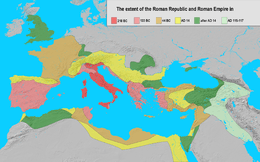14
This article is about the year 14. For the number, see 14 (number). For other uses, see 14 (disambiguation).
| Millennium: | 1st millennium |
|---|---|
| Centuries: | 1st century BC – 1st century – 2nd century |
| Decades: | 10s BC 0s BC 0s – 10s – 20s 30s 40s |
| Years: | 11 12 13 – 14 – 15 16 17 |
| 14 by topic | |
| Politics | |
| State leaders – Sovereign states | |
| Birth and death categories | |
| Births – Deaths | |
| Establishment and disestablishment categories | |
| Establishments – Disestablishments | |
| Gregorian calendar | 14 XIV |
| Ab urbe condita | 767 |
| Assyrian calendar | 4764 |
| Bengali calendar | −579 |
| Berber calendar | 964 |
| Buddhist calendar | 558 |
| Burmese calendar | −624 |
| Byzantine calendar | 5522–5523 |
| Chinese calendar | 癸酉年 (Water Rooster) 2710 or 2650 — to — 甲戌年 (Wood Dog) 2711 or 2651 |
| Coptic calendar | −270 – −269 |
| Discordian calendar | 1180 |
| Ethiopian calendar | 6–7 |
| Hebrew calendar | 3774–3775 |
| Hindu calendars | |
| - Vikram Samvat | 70–71 |
| - Shaka Samvat | N/A |
| - Kali Yuga | 3115–3116 |
| Holocene calendar | 10014 |
| Iranian calendar | 608 BP – 607 BP |
| Islamic calendar | 627 BH – 626 BH |
| Julian calendar | 14 XIV |
| Korean calendar | 2347 |
| Minguo calendar | 1898 before ROC 民前1898年 |
| Seleucid era | 325/326 AG |
| Thai solar calendar | 556–557 |
| Wikimedia Commons has media related to 14. |

The Roman empire in 14 (all colors except dark and light green)
Year 14 (XIV) was a common year starting on Monday (link will display the full calendar) of the Julian calendar. At the time, it was known as the Year of the Consulship of Pompeius and Appuleius (or, less frequently, year 767 Ab urbe condita). The denomination 14 for this year has been used since the early medieval period, when the Anno Domini calendar era became the prevalent method in Europe for naming years.
Events
By place
Roman Empire
- August 19 – Augustus, the first Roman emperor, dies and is declared to be a god.
- September 18 – Tiberius succeeds his stepfather Augustus as Roman emperor.
- Legions on the Rhine revolt after the death of Augustus;[1] Germanicus put down the revolt.
- Germanicus is appointed commander of the forces in Germany, beginning a campaign that will end in 16.[2]
- Germanicus leads a brutal raid against the Marsi, a German tribe on the upper Ruhr river, who are massacred.[3]
- The town and port of Nauportus are plundered by a mutinous Roman legion that was sent there to build roads and bridges.[4]
- Sextus Appuleius and Sextus Pompeius serve as Roman consuls.
- A census indicates that there are 4,973,000 citizens of the Roman Empire.
Asia
- First year of tianfeng era of the Chinese Xin Dynasty.
- Famine hits China. Some citizens turn to cannibalism.
By topic
Art
- The Hellenistic period ends, according to some scholars (usual date 31 BC).
Births
- Lucius Caecilius Iucundus, Pompeian banker (d. 62 AD)
Deaths
- August 19 – Roman Emperor Augustus (b. 63 BC)
- August 20 – Postumus Agrippa, grandson of Roman Emperor Augustus (b. 12 BC)
- Julia the Elder, daughter of Roman Emperor Augustus[5] (b. 39 BC)